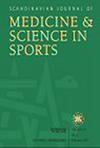在训练有素的男性跑步者长时间跑步时,先进的跑鞋技术对跑步经济性的持续改进。
IF 3.8
2区 医学
Q1 SPORT SCIENCES
引用次数: 0
摘要
本研究评估了高反应泡沫的顶级镀碳鞋(CP-shoe)对跑步经济性(RE)和乳酸门槛(LT)的变化的影响,在长时间跑步之前,期间和之后。10名男性长跑运动员(半程马拉松时间:75±3分钟)完成了一系列测试。最初,在休息良好的状态下,穿着cp鞋或非碳镀鞋(ncp鞋)进行两次分级跑步机测试,以确定RE和lt速度(LTCP和LTNCP)。在不同的天,参与者按随机顺序进行三次80分钟的跑步:两次以95% LTCP(14.7±0.5公里·h-1,每只鞋一次)和一次以95% LTCP(15.2±0.4公里·h-1,只穿cp鞋)。在整个过程中记录RE、血乳酸浓度([La-]b)、心率(HR)和感知运动(博格量表)。每次80分钟跑步后进行分级运动测试,评估RE和lt速度。在匹配的外部工作量(95% LTNCP)下,与ncp鞋相比,cp鞋提高了RE,降低了[La-]b, HR和Borg。在匹配的内部负荷下(每只鞋95%的LT), cp鞋再次表现出更高的RE和更低的HR。然而,在80分钟的跑步过程中,不同鞋子的时间变化过程没有差异(即没有鞋子与时间的相互作用)。在所有80分钟的跑步中,LT速度和RE在运动后得到改善,cp鞋的LT速度比ncp鞋高(+0.5-0.6 km·h-1)。综上所述,在长时间跑步过程中,与普通跑鞋相比,cp鞋提高了RE,降低了感知劳累和[La-]b,尽管不同鞋之间的变化幅度没有差异。本文章由计算机程序翻译,如有差异,请以英文原文为准。
Persistent Improvements in Running Economy With Advanced Footwear Technology During Prolonged Running in Trained Male Runners.
This study evaluated the effects of a top-tier carbon plated shoe with highly responsive foam (CP-shoe) on changes in running economy (RE) and running speed at lactate threshold (LT) before, during, and after prolonged running. Ten male distance runners (half-marathon time: 75 ± 3 min) completed a series of tests. Initially, two graded treadmill tests were undertaken in a well-rested state while wearing either a CP-shoe or non-carbon plated shoe (NCP-shoe) to determine RE and LT-speed (LTCP and LTNCP). On separate days, participants then performed three 80-min runs in randomized order: twice at 95% LTNCP (14.7 ± 0.5 km·h-1, once with each shoe) and once at 95% LTCP (15.2 ± 0.4 km·h-1, CP-shoe only). RE, blood lactate concentration ([La-]b), heart rate (HR), and perceived exertion (Borg scale) were recorded throughout. Each 80-min run was followed by a graded exercise test with assessment of RE and LT-speed. At matched external workload (95% LTNCP), the CP-shoe improved RE and lowered [La-]b, HR, and Borg compared with the NCP-shoe. At matched internal workload (95% LT specific to each shoe), the CP-shoe again demonstrated superior RE and lower HR. However, the time course of changes during the 80-min runs did not differ between shoes (i.e., no shoe × time interactions). Across all 80-min runs, LT-speed and RE improved postexercise, with the CP-shoe yielding higher LT speeds than the NCP-shoe (+0.5-0.6 km·h-1). In conclusion, the CP-shoe enhanced RE and reduced perceived exertion and [La-]b compared with the normal running shoe during prolonged running, although the magnitude of changes over time was not different between shoes.
求助全文
通过发布文献求助,成功后即可免费获取论文全文。
去求助
来源期刊
CiteScore
7.90
自引率
4.90%
发文量
162
审稿时长
3 months
期刊介绍:
The Scandinavian Journal of Medicine & Science in Sports is a multidisciplinary journal published 12 times per year under the auspices of the Scandinavian Foundation of Medicine and Science in Sports.
It aims to publish high quality and impactful articles in the fields of orthopaedics, rehabilitation and sports medicine, exercise physiology and biochemistry, biomechanics and motor control, health and disease relating to sport, exercise and physical activity, as well as on the social and behavioural aspects of sport and exercise.

 求助内容:
求助内容: 应助结果提醒方式:
应助结果提醒方式:


